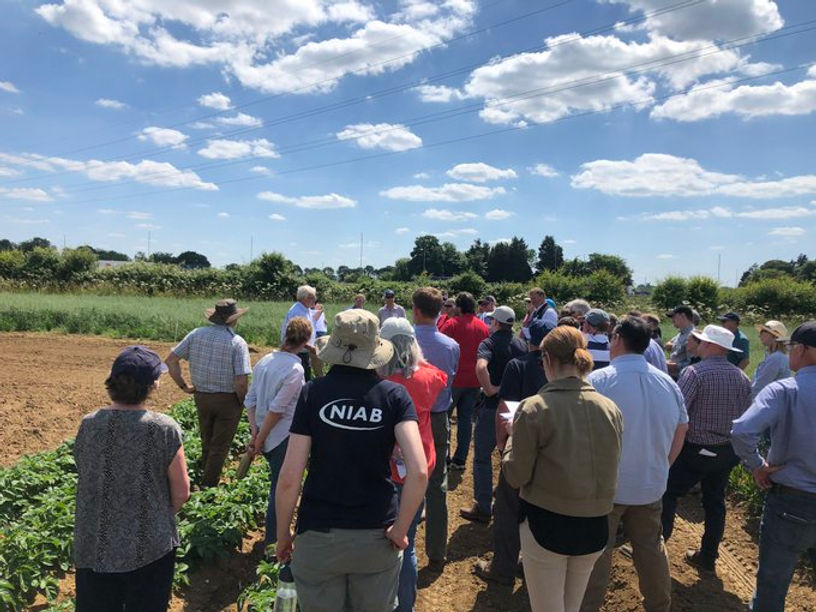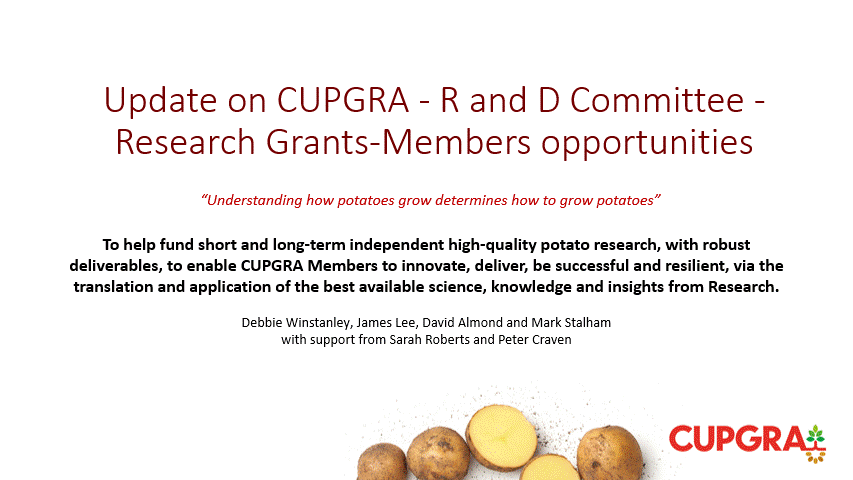
Members' Grants Programme for 2026 now OPEN
Member-led Grants from CUPGRA
CUPGRA can make available grants to fund member-led potato research
Examples of this would include:
-
early-stage, pump-priming or investigative work
-
reviews of current problems and issues
-
£50,000/annum total expected annual awards
-
£2,000 to £20,000 individual grant value
Applications are open to anyone. Grants are subject to:
-
Providing benefit and good value to CUPGRA membership
-
Meeting sound industry and science criteria
-
Having a good communication mechanism for the work
-
Approval of the CUPGRA Executive
Awarded projects will be expected to share the results with CUPGRA members so that the wider community can learn from the research. This might be at summer members’ days, through conference workshops and written reports.
Applications should be made using the CUPGRA Grants Projects - Application Form and returned to Kate Pottle at admin@cupgra.com
Terms and Conditions for awarding CUPGRA Member-led Grants.
The aim of the CUPGRA “Grants Fund” is to support member-led projects which focus on increasing understanding of an aspect of potato production, improving practical potato agronomy and for testing concepts to provide preliminary data to help secure funding for larger future grants.
Applicant Eligibility
These grants are open to active CUPGRA members who are committed to increasing the association’s shared knowledge of potato growth and production, as judged by the CUPGRA Executive Committee and R&D Sub-Committee.
As a guide, the Lead Partner:
• Must have been a member for at least 12 months.
• Understands CUGPRA, how the organisation functions, and the expectations from collaborators.
• Has significant interactions with other CUPGRA members.
• Attends at least two significant technical events (for example, an open day and the annual conference).
These projects should be capable of generating data and conclusions or recommendations applicable to CUPGRA members in general (i.e., not focused solely on the circumstances of the host farm or the project lead).
1. Each project will be led by a CUPGRA member (the “Lead Member” and proposer of the project), with oversight from a CUPGRA Exec member (“Exec supervisor”).
2. The Lead Member is responsible for the design, delivery, data analysis and reporting of the trial. This may be supported by a scientist, normally a member of NIAB Potatoes, with limited advice to enable a robust trial of benefit to the wider CUPGRA membership. The Lead Member will be responsible for the final design, trial delivery and reporting (i.e., not NIAB or the Exec Supervisor).
3. The Exec Supervisor will monitor project progress and be the point of contact (for both the Lead Member and other CUPGRA members interested in the project). The Lead Member will give the Exec Supervisor a detailed copy of the trial design for assessment of suitability by NIAB or other relevant scientists. The Exec Supervisor will co-ordinate feedback on trial design and statistical robustness and reporting.
4. Replication: Unless there is a good scientific or practical reason not to, treatments must be replicated to ensure that results reported are representative of responses to the treatments.
5. Communication: On successful receipt of a Grant the project lead will write a short update for the CUPGRA website to share with the wider membership the work planned and what it hopes to achieve.
6. Communication: Where practical, there should be an opportunity for CUPGRA members to visit the trial site and hear about the trial undertaken. This will benefit the wider membership (show-casing the work that has been funded) and give an opportunity for constructive feedback for the project lead. Depending on the nature of the experiment it may be more convenient to discuss the project at one of the Cambridge CUPGRA open days in the summer.
7. Reporting: This should follow the provided template and include sufficient detail for readers to understand the results and how they were generated.
• Bullet pointed summary/highlights from the experiment, including any recommendations.
• Background motivation for the project.
• Relevant details of trial location and experimental set up e.g., PCN levels, nitrogen applications, planting dates, varieties.
• Methods of treatment application, detailed enough to allow understanding of trial set-up (including number of replicates).
• Robust statistically analysed results showing the effects that the treatments have had on both the target outcome and general crop performance (see appendix), using appropriate statistical tests and standard errors. (Please ask if you have any questions on this).
• Discussion of what the results mean for growers/supply chain.
• Any conclusions which can be drawn from the experiment, any recommendations for others to implement, and recommendations for follow-up research should be clearly laid out.
8. Reporting: Each experiment will be written up for the Annual Report with scientific support, typically from NIAB. They will also be presented at the Annual Research Review by the Lead Member.
9. Payment: Grants will be paid in two instalments, 50% at proof of trial establishment (or at the end of June) and 50% following successful submission of final report, unless agreed otherwise. Invoices for the attention of Kate Pottle, admin@cupgra.com, 01223 342426, CUPGRA, c/o NIAB, 93 Lawrence Weaver Road, Cambridge CB3 0LE.
Appendix – Good practice monitoring
Not all of these factors will be relevant to every experiment, but this is the type of detail that should be included, to set the experiment in context (allowing other growers/agronomists to compare field set up) and to give detail that helps to interpret the results of the experiment.
• Address and GPS or what3words locations.
• Details of field cultivations (including dates, types of machines, tractor used, depth of working), soil type, any sampling carried out.
• Date of first emergence, and 50% emergence.
• Ground cover curves, from weekly records of % ground covered by green leaves, as per use of an app, at specific heights above the crop, or drone flights, that are consistent to a pattern and regular enough to give a good quality ground cover development and decline.
• Yield data – replicated yield digs (minimum 3m dig length is advisable). The number of these to be agreed before planting.
• Yield data should be graded by size, over a fixed grader, in addition to total weight of tubers.
• Pest or bruise assessments in line with NIAB standards.
• Irrigation records may be relevant and enable SMD calculations.
• Full details of assessment methods.



